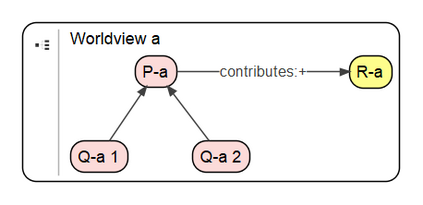LC 00797: verschil tussen versies
Geen bewerkingssamenvatting |
Geen bewerkingssamenvatting |
||
| Regel 1: | Regel 1: | ||
Mutual understanding and shared meaning are key notions in the Social Theory (ST). Unfortunately, they are also confusing notions because understanding and meaning are closely related and often regarded as synonyms. A precise meaning (or understanding for that matter) can be given in the realm of the PQR formula and EM<sub>ont</sub>. | Mutual understanding and shared meaning are key notions in the Social Theory (ST). Unfortunately, they are also confusing notions because understanding and meaning are closely related and often regarded as synonyms. A precise meaning (or understanding for that matter) can be given in the realm of the PQR formula and EM<sub>ont</sub>. | ||
The goal of gaining mutual understanding in a Social Innovation (SI) process is to recognize and acknowledge stakeholders' worldviews in order to create room for movement.[[Bestand:Worldview PQR v 20221002.png|gecentreerd|miniatuur|423x423px| | The goal of gaining mutual understanding in a Social Innovation (SI) process is to recognize and acknowledge stakeholders' worldviews in order to create room for movement. A stakeholder's worldview can be captured with the PQR formula in terms of what and why (P-R, reason of being), and how (Q's, particular ways of doing things). The PQR formula, possibly augmented with core beliefs, explicates a worldview so the stakeholders can comprehend it, and vice versa.[[Bestand:Worldview PQR v 20221002.png|gecentreerd|miniatuur|423x423px|'''Figure''': worldview in terms of PQR.]]Understanding a worldview, however, is not the same as attaching the same meaning or importance to it. A SI process to establish mutual understanding opens the door to understanding the positions stakeholders are taken, which might lead to common grounds in the sense shared meaning. That is, the SI process helps to find shared meaning, but it cannot in itself guarantee that a shared meaning is established. As a bare minimum, stakeholders can agree to disagree by realizing that they need each other in order to make progress. [[Bestand:Shared meaning PQR v 20221002.png|gecentreerd|miniatuur|644x644px|'''Figure''': shared meaning in terms of PQR.]] | ||
[[Bestand:Shared meaning PQR v 20221002.png|gecentreerd|miniatuur|644x644px| | [[Bestand:System governance v 20221020.png|gecentreerd|miniatuur|657x657px|'''Figure''': system governance in terms of PQR.]] | ||
[[Bestand:System governance v 20221020.png|gecentreerd|miniatuur|657x657px| | |||
{{LC Book config}} | {{LC Book config}} | ||
Versie van 3 okt 2022 11:58
Mutual understanding and shared meaning are key notions in the Social Theory (ST). Unfortunately, they are also confusing notions because understanding and meaning are closely related and often regarded as synonyms. A precise meaning (or understanding for that matter) can be given in the realm of the PQR formula and EMont.
The goal of gaining mutual understanding in a Social Innovation (SI) process is to recognize and acknowledge stakeholders' worldviews in order to create room for movement. A stakeholder's worldview can be captured with the PQR formula in terms of what and why (P-R, reason of being), and how (Q's, particular ways of doing things). The PQR formula, possibly augmented with core beliefs, explicates a worldview so the stakeholders can comprehend it, and vice versa.
Understanding a worldview, however, is not the same as attaching the same meaning or importance to it. A SI process to establish mutual understanding opens the door to understanding the positions stakeholders are taken, which might lead to common grounds in the sense shared meaning. That is, the SI process helps to find shared meaning, but it cannot in itself guarantee that a shared meaning is established. As a bare minimum, stakeholders can agree to disagree by realizing that they need each other in order to make progress.
- Lees hiervoor:
- Lees hierna:



